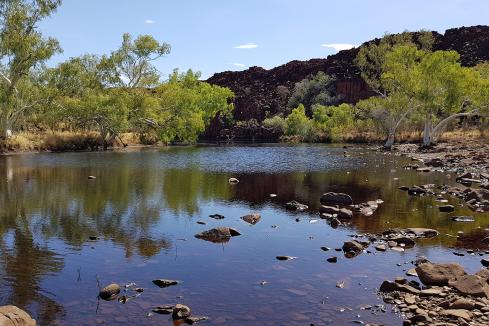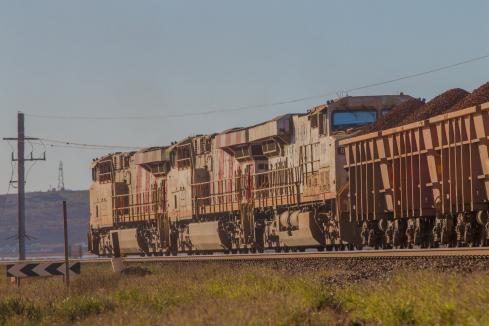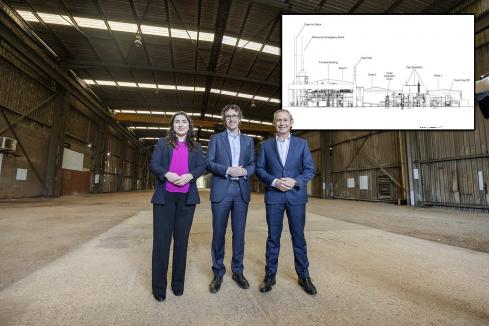Perth-based explorer King River Resources is on the hunt for high-grade gold in elephant country in Australia’s Top End. It has plenty of cash and a gaggle of lucrative-looking targets begging to see a drill bit. With miners selling gold at record highs, King River’s focus on Tennant Creek in the NT, an area that has historically pumped out millions of gold ounces, is timely.


Perth-based explorer King River Resources is on the hunt for high-grade gold in elephant country in Australia’s Top End.
The company has plenty of cash and a gaggle of lucrative looking-targets begging to see a drill bit. And with miners selling gold at record highs, King River’s focus on Tennant Creek in the Northern Territory, a region that has historically pumped out millions of gold ounces, is timely.
King River’s strategy is a multi-pronged approach using modern geophysics and historic drill and rock chip assays to uncover the precious yellow metal. Gold prices have hit record highs in the past couple of months in most currencies and the Australian dollar gold price, now getting towards $3130 an ounce, is providing a boon for those lucky enough to be in production.
The company’s 7000-square-kilometre Tennant Creek project sits in an area that has historically pumped out more than 5.5 million ounces of gold from high-grade iron oxide-copper-gold (IOCG) deposits from as far back as the 1930s.
Interestingly, the area has also produced about 345,000 tonnes of copper and 56 tonnes of silver from more than 100 small-to-medium-sized mines across the massive East Tennant Ridge mineralised zone – running about 350km from Tennant Creek almost continuously into Queensland.
King River has split its massive project into four areas – Tennant East, Rover East, Barkly and Kurundi – and the company now has its eye on 10 high-priority prospects on the back of an extensive geophysics program last year.
Its most recent focus has been on the Tennant East area where management is assessing a swarm of geophysical anomalies along strike from historic mines at the Providence and Lone Star East prospects. Last year, the company put down 17 reverse-circulation (RC) holes for 2790m to ground-truth the geophysics and assays are pending.
King River says the Providence drilling program was designed to test the geophysical targets that are constrained by not just one survey type, but three. Gravity, magnetic and induced-polarisation datasets all show a large, complex geologic zone associated with north-west-trending structures that, when viewed on magnetic data, appear to amalgamate within the Providence target area.
Historic drilling on the structures has returned some encouraging results, with one rotary air-blast (RAB) drillhole intersecting 17m at 0.64 grams per tonne gold from 6m including a 2m hit grading 2.42g/t. One RC hole gave up a 2m intersection grading at a massive 51.8g/t gold from 91m.
The Providence structural targets are along strike from the Bluebird-Perseverance gravity anomaly that was drilled by Tennant Minerals last year and returned assays showing gold and copper. The best of the assays came back at 30.5m at 6.2 per cent copper and 6.8g/t gold including a 17.8m-thick section grading 11.5g/t gold and 16.1m at a massive 10.5 per cent copper.
About 60km south-east of Providence, King River has been working up its Kurundi Main prospect, chasing the source of multiple rock chip samples, all of which went more than 10g/t gold and some that went as high as 17g/t through a 2km-long trend that had never been drilled.
In June last year, the company put 34 RC holes into Kurundi Main, uncovering high-grade results such as a 7m intersection going 6.35g/t gold from 25m including 2m at 21.3g/t with 1m grading a solid 35.26g/t gold.
Other noteworthy gold hits from that campaign include a 6m intercept going 4.77g/t with a 3m section grading 9.28g/t and 1m at a solid 14.76g/t, while a nearby 5m intersection went 3.84g/t from 22m including a 2m section at 7.82g/t with 1m grading 9.99g/t.
King River says the gold-rich vein remains open to the north, south and at depth, with the deepest hole in the campaign intersecting mineralisation.
Notably, the assays also hinted at copper and silver enrichment. Highlights include a 3m hit grading an impressive 8.4 per cent copper from 31m including a 1m section grading as high as 21.81 per cent copper, while the same hole also showed a 4m section going 49.5g/t silver from 30m including 1m at 176g/t.
King River says it has planned another 20,000m of drilling at Tennant Creek for its Commitment prospect, about 2km north-west of Providence where geophysical data has once again uncovered a swarm of anomalies that remain undrilled.
In all, the company has put aside about $2 million to drill out the target-rich project and get some assays to the market.
The Tennant Creek project boundary is just a stone’s throw from the IOCG-rich area containing Emmerson Resources’ Mauritania deposit that was assigned a maiden mineral resource estimate of 256,216 tonnes grading 3.5g/t gold for 28,974 ounces across the indicated and inferred categories back in April 2022.
Emmerson says that number may soon grow after a bonanza drill hit in 2021 suggested exploration potential 70m below the resource envelope, with 3.95m at a massive grade of 57g/t gold and 0.23 per cent copper from 207m.
King River’s Top End ground sits about halfway between Darwin and Alice Springs, not far from the town of Tennant Creek. Conveniently, two of the few main roads in the territory pass through the project area, giving the company a reasonably simple pathway to get its product to market.
The area has not seen much historic exploration, largely because it has about 30m of Cambrian aged rocks as cover, meaning surface expressions of mineralisation can be hard to pick up.
A recent rush of new tenement applications in the area has occurred, however, with rich neighbours Rio Tinto and Newcrest Mining popping up on the maps, in addition to Castile Resources and Middle Island Resources. And if the region does live up to its elephant country aura, King River’s strategic 7000sq-km land holdings will start to look valuable.
Rio Tinto has entered the area by picking-up some exploration ground just to the east of King River’s Tennant East Project and Castile is working some ground at its Rover project adjacent to King River’s Rover East.
Castile has pinned a multi-element resource to its Rover 1 deposit of 6.9 million tonnes grading 1.74g/t gold, 2.07g/t silver, 1.2 per cent copper, 0.14per cent bismuth and 0.06 per cent cobalt for 386,000 ounces of gold, 459,000 ounces of silver, 83,000 tonnes of copper, 9400 tonnes of bismuth and 4100 tonnes of cobalt.
While King River is focusing on its NT project, it also has some gold-prospective ground across the border in Western Australia’s Kimberley region, about 100km south of the port of Wyndham and 200km south-west of the town of Kununurra.
The company has identified a smorgasbord of exploration targets across its vastly-underexplored tenements at its Mt Remarkable project area where it is the sole holder of the ground through its subsidiary Whitewater Minerals.
The targets are spread across a huge north-east/south-west-trending anticlinal fold belt that was a thoroughfare for gold-rich fluids during mineralising events. It now hosts a platter of exploration targets, but remains vastly underexplored.
According to King River, past exploration along the prospective Whitewater volcanic horizon trend at Mt Remarkable has been sparse, but it believes that hints at the potential for the ground to hold high-grade gold discoveries.
The company finished the past financial quarter with more than $3.9 million in the kitty, thanks in part to $5 million received from Tivan mid-last year for the sale of the Speewah project – King River’s former vanadium/titanium play in WA. As part of that deal, King River can expect to receive the final instalment of a further $5 million next month.
The company is cashed up and ready to drill a swarm of good-looking gold targets at a time when the price for the precious yellow metal is booming. And remarkably, firms such as J.P. Morgan are predicting it to hit US$2300 an ounce by 2025 – that’s more that AU$3500 per ounce at today’s exchange rate.
Is your ASX-listed company doing something interesting? Contact: matt.birney@businessnews.com.au













